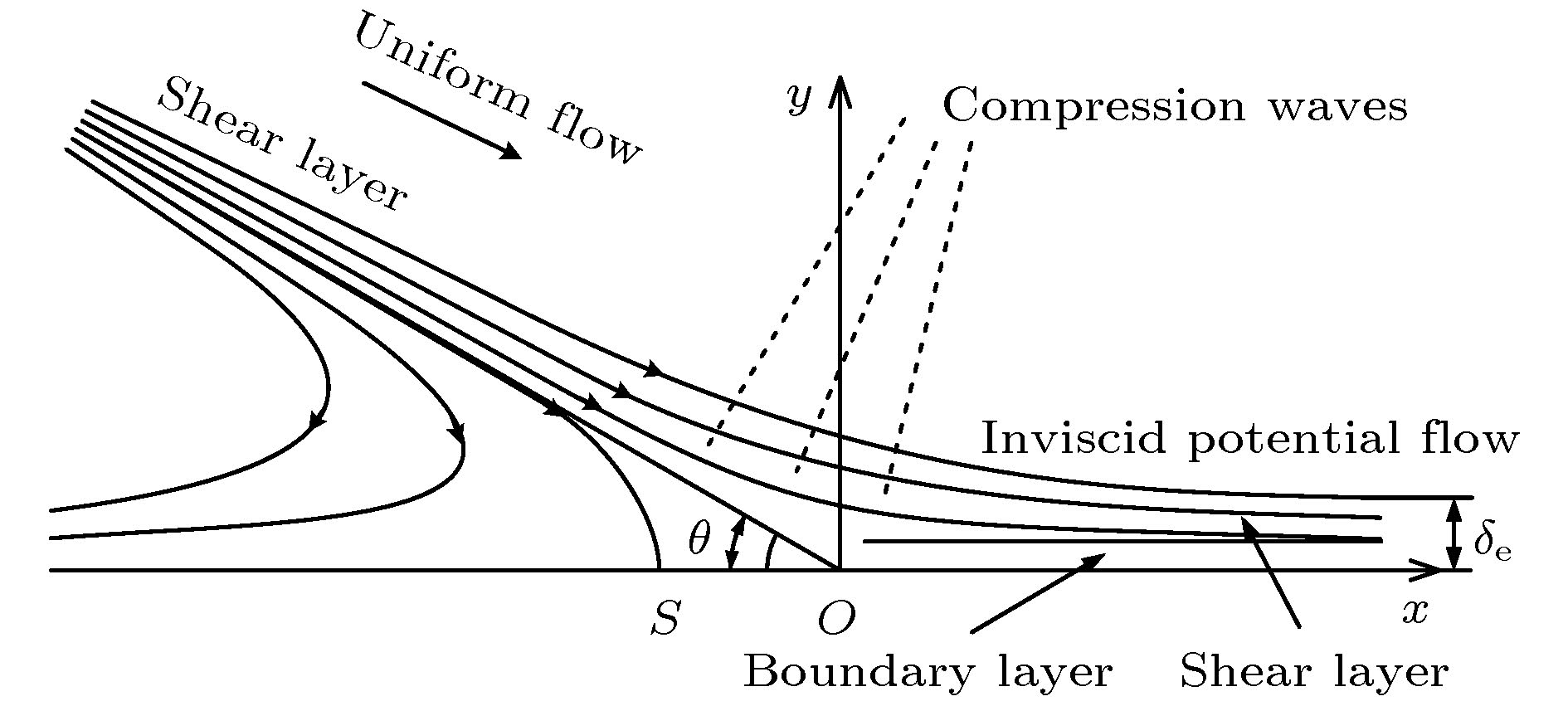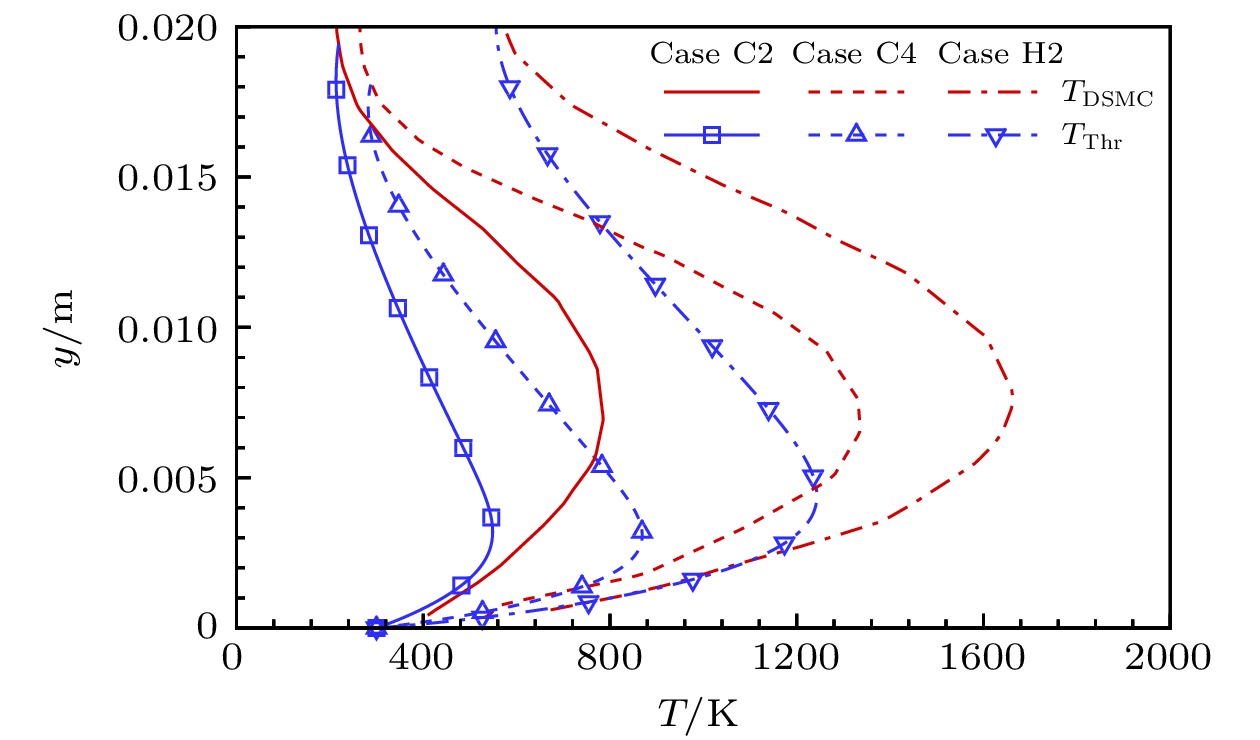-
Hypersonic reattachment flow usually causes extremely high wall heat flux, which is of great concern in engineering. The flow can be modeled as a high-speed shear layer impinging on a wall at a certain angle, which forms an oblique stagnation-point flow in the vicinity of the stagnation point, including stagnation-component and shear-component. Previous work focused on incompressible oblique stagnation-point flow, while in the present study a semi-analytical-semi-numeric solution is given via the self-similar method for compressible oblique stagnation-point flow. Through the comparison and validation with the numerical results, it is found that the flow model can well simulate the heat transfer near the wall in the flow of uniform shear layer impinging on the wall caused by hypersonic reattachment. With the analysis of the contribution of the energy transport and the heat production in the flow model, it is found that the compression effect and dissipation effect are mainly caused by the shear-component, leading to a significant convective heat transfer in the flow direction, which is different from the case of the classic boundary layer. Then the temperature of the flow near the wall rises rapidly after reattachment, resulting in a high heat flux to the wall. Parameter analysis indicates that the wall heat-transfer coefficient is related to the dimensionless wall temperature gradient and the thickness of the boundary layer. The former is mainly controlled by the shear-component parameter
$H_{\zeta}$ , and the latter is negatively correlated with the stagnation-component parameter$H_{\beta}$ . Further analysis shows that the wall heat-transfer coefficient has a linear relationship with$H_{\zeta}$ and is proportional to$\sqrt{H_{\beta}}$ when$H_{\beta}$ is small. This work provides a theoretical basis and solution for studying on the hypersonic reattachment flow, and it is also an extension of the asymmetric stagnation boundary layer theory.-
Keywords:
- oblique stagnation-point /
- reattachment /
- shear layer /
- heat transfer
[1] Dolling D S 2001 AIAA J. 39 1517
 Google Scholar
Google Scholar
[2] van Driest E R 1956 Aeronaut. Eng. Rev. 15 26
[3] Lees L 1956 J. Jet Propul. 26 259
 Google Scholar
Google Scholar
[4] Fay J A, Riddell F R 1958 J. Aerosp. Sci. 25 73
 Google Scholar
Google Scholar
[5] 李邦明 2013 博士学位论文 (北京: 中国科学院大学)
Li B M 2013 Ph. D. Dissertation (Beijing: University of Chinese Academy of Sciences) (in Chinese)
[6] Stuart J T 1959 J. Aerosp. Sci. 26 124
 Google Scholar
Google Scholar
[7] Tamada K 1979 J. Phys. Soc. Jpn. 46 310
 Google Scholar
Google Scholar
[8] Dorrepaal J M 1986 J. Fluid Mech. 163 141
 Google Scholar
Google Scholar
[9] Tooke R M, Blyth M G 2008 Phys. Fluids 20 33101
 Google Scholar
Google Scholar
[10] Lyell M J 1990 Phys. Fluids A 2 456
 Google Scholar
Google Scholar
[11] Chapman D R, Kuehn D M, Larson H K 1958 Investigation of Separated Flows in Supersonic and Subsonic Streams with Emphasis on the Effect of Transition (Washington, D.C.: National Advisory Committee for Aeronautics) Report No. NACA-TR-1356
[12] Zapryagaev V I, Kavun I N, Lipatov, I I 2013 Prog. Flight Phys. 5 349
 Google Scholar
Google Scholar
[13] Gadd G E, Holder D W, Regan J D 1954 Proc. R. Soc. London, Ser. A 226 227
 Google Scholar
Google Scholar
[14] Bernardini M, Asproulias I, Larsson J, Pirozzoli S, Grasso F 2016 Phys. Rev. Fluids 1 84403
 Google Scholar
Google Scholar
[15] Shang J S, Hankey Jr W L, Law C 1976 AIAA J. 14 1451
 Google Scholar
Google Scholar
[16] Davis R T 2003 J. Spacecr. Rockets 40 787
 Google Scholar
Google Scholar
[17] Dorodnitsyn A A 1942 Prikl. Mat. Mekh. 6 449
[18] Howarth L 1948 Proc. R. Soc. London, Ser. A 194 16
 Google Scholar
Google Scholar
[19] Hayes W D and Probstein R F 1959 Hypersonic Flow Theory (New York and London: Academic Press) pp343–344
[20] Simeonides G 1992 Ph. D. Dissertation (Bristol: University of Bristol)
[21] Eckert E R G 1955 J. Aeronaut. Sci. 22 585
 Google Scholar
Google Scholar
[22] Anderson Jr J D 2006 Hypersonic and High-Temperature Gas Dynamics (2nd Ed.) (Reston, Virginia: AIAA Inc.) pp341–343
[23] Moss J N, Bird G A 2005 AIAA J. 43 2565
 Google Scholar
Google Scholar
[24] Wang Z H, Yu Y L, Bao L 2018 AIAA J. 56 3593
 Google Scholar
Google Scholar
-
表 A1 DSMC模拟压缩拐角分离-再附流动的流动参数
Table A1. Flow conditions of the compression ramp flow in DSMC simulations.
Case No. $ M_\infty $ $ {Re}_L / 10^4 $ $ \theta /(^{\circ}) $ $ T_\infty $/K $ T_{\rm{w}} $/K L/m A1 9 1 25 60 300 1 B1 9 2 25 60 300 1 B2 11 2 25 60 300 1 C1 9 5 25 60 300 1 C2 11 5 25 60 300 1 C3 13 5 25 60 300 1 C4 15 5 25 60 300 1 D1 13 10 25 60 300 1 D2 15 10 25 60 300 1 E1 11 5 21 60 297 1 E2 11 5 24 60 297 1 E3 11 5 27 60 297 1 E4 11 5 30 60 297 1 F1 15 2 30 60 300 1 G1 15 5 24 60 300 1 G2 15 5 27 60 300 1 H1 11 2 25 100 300 1 H2 11 2 25 150 300 1 H3 11 2 25 200 300 1 H4 11 2 25 250 300 1 I1 11 5 25 60 100 1 I2 11 5 25 60 200 1 I3 11 5 25 60 250 1 I4 11 5 25 60 350 1 I5 11 5 25 60 450 1 表 A2 再附点后局部的无量纲流动参数
Table A2. Dimensionless parameters of the vicinity behind the reattachment point
Case No. $ M_{\rm{e}} $ $ H_{\beta} \times 10^4 $ $ H_{\zeta} \times 10^3 $ $ D_{\rm{e}} $ $ {\bar T}_{\rm{w}} $ $ \theta $ A1 4.82 1.79 12.25 15.2 1.64 13.6 B1 4.60 1.60 10.27 16.4 1.51 14.0 B2 5.57 1.16 6.45 19.9 1.43 15.0 C1 4.69 0.97 5.21 23.1 1.57 15.3 C2 5.44 0.78 3.89 25.6 1.37 15.8 C3 6.15 0.66 3.22 27.5 1.23 16.0 C4 6.55 0.68 3.10 27.7 1.04 16.5 D1 6.00 0.51 2.32 32.4 1.18 16.6 D2 6.28 0.51 2.17 32.9 0.96 17.0 E1 5.90 0.57 4.93 23.0 1.56 12.1 E2 5.60 0.71 4.07 25.1 1.42 14.8 E3 5.18 0.93 3.86 25.4 1.25 17.2 E4 4.71 1.28 3.99 24.5 1.07 19.7 F1 5.71 1.75 5.17 21.0 0.82 20.2 G1 7.05 0.50 2.61 30.4 1.19 15.5 G2 5.99 0.90 3.40 26.1 0.88 18.0 H1 5.48 1.17 6.40 18.9 0.83 15.1 H2 5.38 1.22 6.52 18.2 0.54 15.3 H3 5.46 1.12 5.90 18.9 0.41 15.4 H4 5.08 1.36 7.29 16.8 0.36 15.3 I1 5.35 0.90 3.88 23.4 0.45 16.9 I2 5.50 0.78 3.53 25.7 0.93 16.6 I3 5.50 0.75 3.57 26.1 1.17 16.2 I4 5.43 0.80 4.10 25.5 1.59 15.6 I5 5.45 0.73 4.06 27.1 2.07 15.0 -
[1] Dolling D S 2001 AIAA J. 39 1517
 Google Scholar
Google Scholar
[2] van Driest E R 1956 Aeronaut. Eng. Rev. 15 26
[3] Lees L 1956 J. Jet Propul. 26 259
 Google Scholar
Google Scholar
[4] Fay J A, Riddell F R 1958 J. Aerosp. Sci. 25 73
 Google Scholar
Google Scholar
[5] 李邦明 2013 博士学位论文 (北京: 中国科学院大学)
Li B M 2013 Ph. D. Dissertation (Beijing: University of Chinese Academy of Sciences) (in Chinese)
[6] Stuart J T 1959 J. Aerosp. Sci. 26 124
 Google Scholar
Google Scholar
[7] Tamada K 1979 J. Phys. Soc. Jpn. 46 310
 Google Scholar
Google Scholar
[8] Dorrepaal J M 1986 J. Fluid Mech. 163 141
 Google Scholar
Google Scholar
[9] Tooke R M, Blyth M G 2008 Phys. Fluids 20 33101
 Google Scholar
Google Scholar
[10] Lyell M J 1990 Phys. Fluids A 2 456
 Google Scholar
Google Scholar
[11] Chapman D R, Kuehn D M, Larson H K 1958 Investigation of Separated Flows in Supersonic and Subsonic Streams with Emphasis on the Effect of Transition (Washington, D.C.: National Advisory Committee for Aeronautics) Report No. NACA-TR-1356
[12] Zapryagaev V I, Kavun I N, Lipatov, I I 2013 Prog. Flight Phys. 5 349
 Google Scholar
Google Scholar
[13] Gadd G E, Holder D W, Regan J D 1954 Proc. R. Soc. London, Ser. A 226 227
 Google Scholar
Google Scholar
[14] Bernardini M, Asproulias I, Larsson J, Pirozzoli S, Grasso F 2016 Phys. Rev. Fluids 1 84403
 Google Scholar
Google Scholar
[15] Shang J S, Hankey Jr W L, Law C 1976 AIAA J. 14 1451
 Google Scholar
Google Scholar
[16] Davis R T 2003 J. Spacecr. Rockets 40 787
 Google Scholar
Google Scholar
[17] Dorodnitsyn A A 1942 Prikl. Mat. Mekh. 6 449
[18] Howarth L 1948 Proc. R. Soc. London, Ser. A 194 16
 Google Scholar
Google Scholar
[19] Hayes W D and Probstein R F 1959 Hypersonic Flow Theory (New York and London: Academic Press) pp343–344
[20] Simeonides G 1992 Ph. D. Dissertation (Bristol: University of Bristol)
[21] Eckert E R G 1955 J. Aeronaut. Sci. 22 585
 Google Scholar
Google Scholar
[22] Anderson Jr J D 2006 Hypersonic and High-Temperature Gas Dynamics (2nd Ed.) (Reston, Virginia: AIAA Inc.) pp341–343
[23] Moss J N, Bird G A 2005 AIAA J. 43 2565
 Google Scholar
Google Scholar
[24] Wang Z H, Yu Y L, Bao L 2018 AIAA J. 56 3593
 Google Scholar
Google Scholar
Catalog
Metrics
- Abstract views: 9418
- PDF Downloads: 138
- Cited By: 0


















 DownLoad:
DownLoad:






























